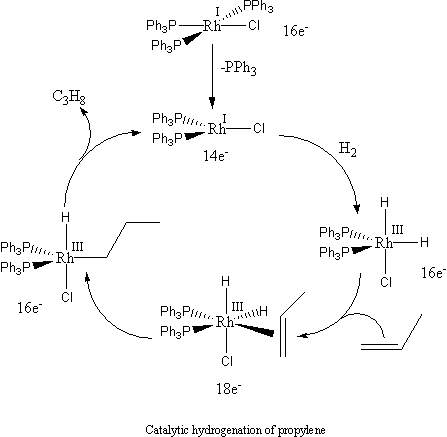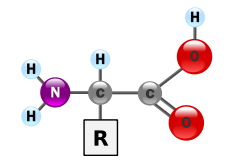Rhodium-catalyzed hydrogenation
Rhodium catalyzed hydrogenation is a chemical reaction that typically involves the addition of pairs of hydrogen atoms to another compound or element in the presence of a Rhodium complex catalyst. The addition of hydrogen to double or triple bonds in hydrocarbons is a type of redox reaction that can be thermodynamically favorable without a catalyst. For example, the addition of hydrogen to an alkene has a Gibbs free energy change of -101kJ mol-1.[1] However, the reaction rate for most hydrogenation reactions is negligible without extremely high temperatures or pressures. Rhodium (Rh) is a transition metal, and the complexes it can form act as catalysts to allow hydrogenation and other chemical reactions to occur at lower temperatures and lower pressures. The rhodium complex catalyst is able to bind both the unsaturated substrate as well as the H2 in order to facilitate the transfer of hydrogen to substrate. Other transition metals such as platinum, palladium, and nickel can also act as catalysts in the hydrogenation process.
Preparation of rhodium hydrogenation catalysts
Rhodium hydrogenation catalysts can be derived from cationic complexes such as [Rh(diene)Ln]+, where L is a neutral donor ligand and n is either 2 or 3.[2] Examples of the dienes found in these complexes could be 1,3-cyclohexadiene, norbornadiene, 1,3-butadiene, or 1,5-clycooctadiene. With hydrogen, these species will all yield catalytically active solutions by means of reductive elimination of the diene. The rhodium catalytic precursors are generally yellow or orange in color. As the hydrogen reduces the diene, the color fades and the solution becomes colorless.[2]
Common hydrogenation reactions
Rh complexes most often act as catalysts for the hydrogenation of olefins, dienes, alkenes, alkynes, imines, ketones, and hydrosilate ketones. A common reaction is the hydrogenation of benzothiophene (BT) to 2,3-dihydrobenzothiophene (DHBT) under mild reaction conditions.[3]
Hydrogenation of alkenes with Wilkinson’s catalyst
Wilkinson’s catalyst is a commonly studied system consisting of an square planar Rh(I) complex that has the formula [RhClPPh3)3]. At pressures of hydrogen close to 1atm at room temperature, it is used to hydrogenate a wide variety of alkenes and alkynes. It most often catalyzes the hydrogenation of terminal alkenes by the oxidative addition of H2 to the 16-electron complex to form an 18-electron complex before returning to the 16-electron form.[1]
Wilkinson’s catalyst is highly sensitive to the size of the alkene substrate. It can only catalyze hydrogenation of alkenes that are not too sterically crowded. Additionally, it does not catalyze the hydrogenation of ethene because ethene forms a strong complex with the Rhodium complex that does not further react.

Hydrogenation of alkynes
Alkynes can additionally undergo catalytic hydrogenation with rhodium catalysts. In this process hydrogenation occurs in a step-wise process. The formation of an alkene occurs first, and then the formation of the alkane follows. When using a rhodium catalyst, it is difficult to stop the reaction at the alkene stage.
Hydrogenation of aromatic cyclic arenes
Soluble rhodium complexes catalyze the hydrogenation of benzene, naphthalene, and anthracene to monocyclic arenes. The catalytic complexes allow the hydrogenation to occur under mild reaction conditions. The complex Rh/phenlyanthranylic acid is a catalysis for the conversion of benzene. [Cp*RhCl2]2 acts as a catalysis for the conversion of benzene, anthracene, naphthalene and other polyaromatics.[4]
The rhodium catalyst [Rh(I)PPh3]+ is used to reduce benzene to cyclohexane in the interlamellars of montmorillonite clay.[5]
Hydrogenation of nitriles
Hydrogenation of nitriles by means of a catalytic rhodium complex yields primary, secondary, and tertiary amines, as well as aldehydes, and alcohols. The major product obtained depends on the catalyst complex used. Most often the hydrogenation of low molecular mass aliphatic nitriles yields secondary amines.[6]
Hydrogenation of pyridines and N-heterocyles
Rhodium complexes can act as catalysts to allow the hydrogenation of pyridines at lower temperatures and pressures. An example is the hydrogenation of 2-methylpyridine to 2-methylpiperdine with the complex [Cp*Rh(NCMe03]2+.[4] Hydrogen addition to the C=N is the key step in this process because it breaks the aromaticity of the ring. Hydrogenation, or hydrogen addition, to the C=N bond as well as hydrogen addition to the C=C bond is thought to be reversible.
Rhodium precursor catalysts reduce the N-containing ring in N-heterocytes. N-heterocyte substrates include: quinoline, isoquinoline, indole, acridine, and benzoquiolines. In most of these reactions the oxidation state of the metal and the number of hydride ligands are not clear.
Table of Common Catalysts and Substrates[4]
| Catalyst | Substrate |
|---|---|
| RhCl2(DMF)(py)2(BH4), Rh6(CO)16 | Pyridine, Quinoline |
| [Cp*Rh(NCMe)3]2+ | Pyridine, Quinoline, Polynuclear N-heteroaromatics |
| RhCl(PPh3)3, Rh Metal Carbonyls | Polynuclear N-heteroaromatics |
Hydrogenation of carbon to carbon double bond
Rh complexed with BINAP is a chiral catalyst that is used for the production of enantiomerically pure amino acids from a-(acylamino) acrylic acids.[3]

Rh-BINAP also acts as a chiral catalyst for the synthesis of menthol.[7]
Important role in science and technology
Rhodium bound to chiral phosphorus ligands
As different enantiomers may have different activities, producing a particular chiral product has become important for pharmaceutical and agrochemical production. Rhodium (I) complexes related to the Wilkinson’s catalyst have been made to produce optically active products in enantioselective reactions. These complexes generally contain a chiral phosphine.
Rhodium bound to chiral phosphorus ligands are catalysts that allow homogenous asymmetric hydrogenation. With such a catalyst, prochiral olefins, ketones, and imines can be reduced by hydrogen into particular chiral compounds. The alkene must be prochiral in order for the reaction to yield the resulting complexes.
Common ligands for asymmetric hydrogenation include DIOP, DIPAMP, BPPFOH, BPPM, and other C2-symmetric bisphosphine ligands.[3] C1-symmetric PHOX ligands having also been used for transfer hydrogenation.[8]

Industrial uses
Commercially, Rhodium complexes containing phosphine-ligands are used to hydrogenate prochiral enamides.[9] A Rhodium complex with the DIPAMP ligand is important for synthesizing L-DOPA in high enantiomerical purity.[1] It is a form of asymmetric hydrogenation and important industrially. This because the L-isomer of L-DOPA has the desired therapeutic effect for the treatment of Parkinson’s disease. The S-isomer has no such effect.
Rhodium catalyzed hydrogenation has also been successfully used in the herbicide production of S-metolachlor, which uses a Josiphos type ligand (called Xyliphos).[10] This is important because the S-isomer produces the majority of the activity.
References
- ↑ 1.0 1.1 1.2 Atkins, et al. Shriver and Atkins’ Inorganic Chemistry W.H. Freeman & Co., 5th Ed., 2010. ISBN 978-1-4292-1820-7.
- ↑ 2.0 2.1 R.R. Schrock, J.A. Osborn: J. Am. Chem. Soc., 98 (1976).
- ↑ 3.0 3.1 3.2 Albrecht, J.; Nagel, U. Angew. Chem. Int., 35, 1996.
- ↑ 4.0 4.1 4.2 Russel, M.J.; White, C.; Maitlis, P.M. J. Chem. Soc. Chem.Commun., 427, 1977.
- ↑ Halligudi, S.B., et al. “Hydrogenation of Benzene to Cyclohexane Catalyzed by Rhodium (I) Complex Supported on Montmorillonite Clay”. React. Kinet. Catal. Lett., 48, 1992.
- ↑ Sanfilippo, Domenico. “Hydrogenation and Dehydrogenation”. Ullmann's Encyclopedia of Industrial Chemistry, 2009.
- ↑ Akutagawa, S. "Asymmetric synthesis by metal BINAP catalysts". Applied Catalysis A 128 (2): 171, 1995. doi:10.1016/0926-860X(95)00097-6.
- ↑ Braunstein, Pierre; Naud, Fre´de´ric; Rettig, Steven J. (1 January 2001). "A new class of anionic phosphinooxazoline ligands in palladium and ruthenium complexes: catalytic properties for the transfer hydrogenation of acetophenone". New Journal of Chemistry 25 (1): 32–39. doi:10.1039/B004786O.
- ↑ W. S. Knowles, J. Chem. Educ., 63, 222, 1986.
- ↑ H.-U. Blaser., B. Pugin, F. Splinder and M. Thommen; Acc. Chem. Res., 40, 1240, 2007.